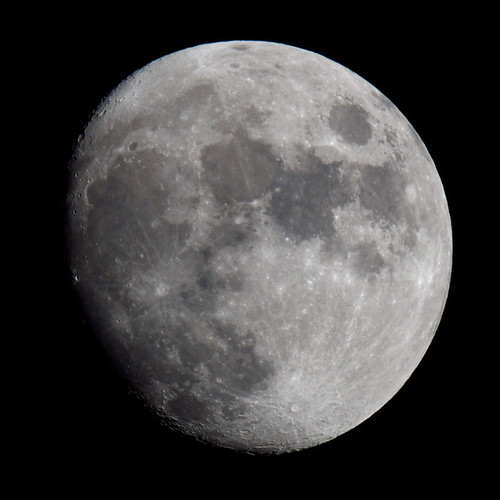The Moon, magnified
I first tried photographing the Moon with my new 2× Powermate on May 8, but my 80-mm Sky-Watcher Equinox refractor couldn’t reach focus with the Powermate. It needed more focus travel, apparently. (The Powermate’s special T-ring adapter1 hadn’t shown up yet, so I connected my camera to the Powermate using my existing T-ring adapter and the Powermate’s two-inch eyepiece adapter.) I had to make do with this shot instead, taken without the Powermate.
I had the Powermate’s T-ring adapter on order at Focus Scientific (great people; shop there); I picked it up on Monday, along with a two-inch extension tube, which I hoped would allow me to achieve focus with all this gear. I got to test this combination out on Thursday night. As you can see, it worked:
The advantage of photographing the Moon with a 2× Powermate is that it doubles the focal length — in this case from 500 mm to 1,000 mm — making your target object much larger to the camera and covering more pixels on its sensor. But it’s not without its challenges.
Because it doubles the telescope’s focal ratio — in this case from f/6.25 to f/12.5 — it requires longer exposures. At nearly a full moon, this image was taken at 1/250 s, the same shutter speed as this crescent Moon shot without the Powermate (a crescent Moon is much less bright than a full Moon); this shot of a full Moon, similar to the one above, was at 1/2000 s.
The combination of these two factors — larger image, slower shutter speed — is going to require me to get a better, sturdier mount than the camera tripod I’ve been using in an improvised manner. The tripod was jittery to start with, but that wasn’t really a problem because (a) I was using ridiculously fast shutter speeds when shooting a bright moon at f/6.25 and (b) I was photographing a tiny Moon that could bounce all over the camera’s field of view without disappearing. Not only am I now trying to capture a larger image at slower speeds, but the Powermate adds more than half a kilogram to the back end of the telescope, making it harder to hold steady and to centre it on the image. I was actually supporting the camera in my hands as I took pictures. I’d never be able to take a shot like this with this setup — especially since the exposure would have to be much longer with the Powermate.
So my next step is to graduate from using a rather flimsy camera tripod to a sturdier mount, perhaps a grab-and-go alt-azimuth mount for observing that would also double for lunar photography. But that’s a topic for another post.
1 A T-ring adapter is one of two items used to connect a camera to a telescope. The other part is the T-ring, which attaches to a camera’s lens mount and allows the camera to connect to a standard T-ring adapter, which then goes where the eyepiece or star diagonal goes.
